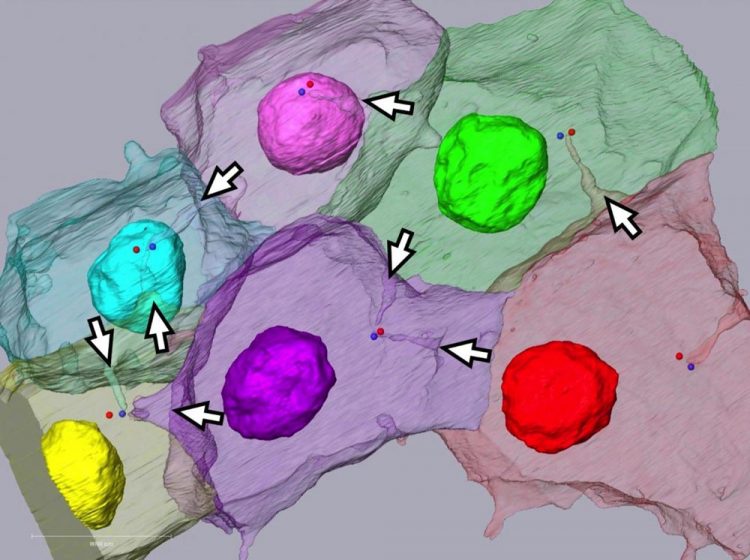Discovery of a unique subcellular structure determining the orientation of cell division

In the cell, the invaginations (white arrows) extend to the centrosome (blue/red dots). Credit: NIBB
How many times a cell undergoes cell division and how the two daughter cells are positioned after the division can be critical for shaping the animal. Although the machinery essential for cell division is well characterized and evolutionarily conserved, it remains unknown in most animals how a cell division can become oriented relative to the animal's body axis.
The work by Negishi et al., published recently in the electronic journal eLife, has revealed that in the sea squirt (Ciona intestinalis) embryo, the orientation of the cell division machinery in epithelial cells is controlled by a unique cell membrane structure, which we call an “invagination”.
The first author, Dr. Takefumi Negishi, recalls “When I observed this structure dynamically moving and extending within the cell, I immediately thought this might be playing an essential role for cellular function.”
Live imaging by fluorescence microscopy revealed that the invaginations originate from the posterior (tail) side of each epithelial cell and grows intracellularly toward the centrosome, an essential component of the cell division machinery. Using a specialized electron microscopy called “SBF-SEM”, the authors demonstrated that the tip of invagination associates closely with the centrosome.
Furthermore, laser cutting of the invagination resulted in immediate recoil of both cut ends to opposite directions, highlighting that this polarized membrane structure is under tension.
Based on these findings, the authors propose an entirely new model for controlling cell division orientation, which involves the polarized membrane structure repositioning the cell division machinery to one end of the cell, thus orientating the subsequent cell division.
Professor Naoto Ueno, who co-supervised the current study, states “We hope our findings facilitates studies on similar membrane structures in other animals that might have diverse biological functions.”
This study was conducted in collaboration between the National Institute for Basic Biology (Japan), the National Institute for Physiological Sciences (Japan) and The National Center for Scientific Research (France).
eLife
“Physical association between a novel plasma-membrane structure and centrosome orients cell division”
Takefumi Negishi, Naoyuki Miyazaki, Kazuyoshi Murata, Hitoyoshi Yasuo, Naoto Ueno
DOI: 10.7554/eLife.16550
Media Contact
All latest news from the category: Life Sciences and Chemistry
Articles and reports from the Life Sciences and chemistry area deal with applied and basic research into modern biology, chemistry and human medicine.
Valuable information can be found on a range of life sciences fields including bacteriology, biochemistry, bionics, bioinformatics, biophysics, biotechnology, genetics, geobotany, human biology, marine biology, microbiology, molecular biology, cellular biology, zoology, bioinorganic chemistry, microchemistry and environmental chemistry.
Newest articles

First-of-its-kind study uses remote sensing to monitor plastic debris in rivers and lakes
Remote sensing creates a cost-effective solution to monitoring plastic pollution. A first-of-its-kind study from researchers at the University of Minnesota Twin Cities shows how remote sensing can help monitor and…

Laser-based artificial neuron mimics nerve cell functions at lightning speed
With a processing speed a billion times faster than nature, chip-based laser neuron could help advance AI tasks such as pattern recognition and sequence prediction. Researchers have developed a laser-based…

Optimising the processing of plastic waste
Just one look in the yellow bin reveals a colourful jumble of different types of plastic. However, the purer and more uniform plastic waste is, the easier it is to…



